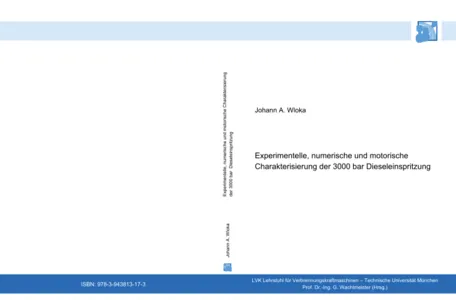Dissertation, 2016
from Dr.-Ing. Johann Wloka
Abstract
The injection system of a direct injecting Diesel engine is until today one of the most valueable components on an engine. With the injection system it gets possible to influence the mixture formation and subsequently the emissions of an engine. The development of fuel injection equipment is coined with the desire to increase the injection pressure. In com- bination with measures like EGR or high boost pressures it is possible to achieve lowest emission levels. To achieve the ambitious fuel consumption goals, the injection pressure is increased steadily. Available injection systems for private and commercial vehicles reach to injection pressures up to approx. 2000 bar. An increase up to 3000 bar is heavily under discussion right now. Numerous studies and published investigations show a positive influence on mixture for- mation, combustion and emission behaviour in combination with high injection pressures. In order to identify further correlations and sensitivities regarding the emission formation, especially the particle emissions, at such high injection pressures a modified on-road serial injection system was used in this particular study. The invesitigations on the influence of 3000 bar injection pressure on the spray- and mixture-formation, as well as on the hydraulics and in the end on the engine behaviour was carried out with several injection nozzle geometries. The investigations are divided in a numerical and an experimental part. In CFD-Calculations of the nozzle-flow, the influence of such high rail pressures on the ca- vitation and the fluid-flow inside the nozzle was studied. The experimental investigations break down to basically three tests, the hydraulical characterization of the injector, the optical invetigations of the spray pattern and the engine behaviour. The hydraulical investigations were carried out at an injection rate analyzer and deli- ver in combination with the optical investigations a basic understanding for the engine behaviour. As a reference, the serial nozzle design was used, to identify the potential of adapted nozzles for 3000 bar injection pressure. The study finnishes with investigations of the potential to reduce NOx- and soot-emissions for high rail pressures and adapted nozzle-design. The focus here was the reduction of PN-emissions, due to the fact that with the new EURO VI-Emission legislative a new restriction was established which needs to be fulfilled from all engines in future.
Extent: 198 pages
ISBN: 978-3-94381-17-3
Price: 33 € ( 2 € for dispatch)
Ordering: verlag(at)lvk.mw.tum.de
